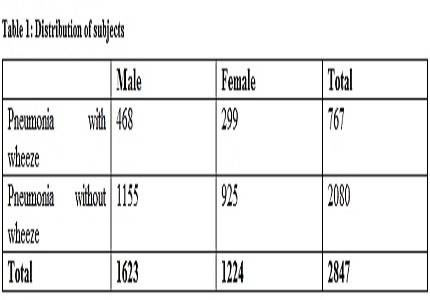Clinical study of pneumonia with wheeze in children
Abstract
Introduction: In developing world, important reason for morbidity and mortality in children are acute respiratory tract infections. Annually about 3.8 million children die because of acute respiratory illnesses mostly in developing world. Pneumonia is often associated with wheeze in significant number of cases.
Objective: The study was aimed to assess the clinical and epidemiological profile of admitted patients with diagnosis of Pneumonia in department of paediatrics with or without wheeze on the basis of age and sex.
Methods: A retrospective observational study in Department of paediatrics, Gandhi Medical College and associated Hospital from May 2013 to May 2015. Children admitted in department of paediatrics aged up to 12 years with clinical manifestations suggestive of pneumonia were included (fever, cough, rapid breathing, crepitation and wheeze). Patients with history of Tuberculosis, Asthma and associated cardiac problems were excluded. Outcome was assessed on the basis of magnitude of problem and morbidity.
Results: A total of two thousand eight hundred and forty seven children with diagnosis of pneumonia were admitted and out of them seven hundred and sixty seven (27%) children had wheeze. Most of the children having pneumonia with wheeze come under the age group of 2 to 12 months. Male children are affected more than female children.
Conclusion: In significant number of children, pneumonia is associated with wheeze, especially in the age group of 2-12 months. It is also common in children with age group of 1-5 yrs. Therefore, pneumonia is a significant cause of morbidity in children. Morbidity may further increase when pneumonia is associated with wheeze.
Downloads
References
2. Martinez FD, Wright AL, Taussig LM, Holberg CJ, Halonen M, Morgan WJ.Asthma and wheezing in the firstsixyearsoflife. The GroupHealthMedicalAssociates.N Engl J Med. 1995 Jan 19;332(3):133-8. [PubMed]
3. Shah N, Ramankutty V, Premila PG, Sathy N. Risk factors for severe pneumonia in children in south Kerala: a hospital-based case-control study. Journal of tropical pediatrics. 1994 Aug 1;40(4):201-6.
4. McIntosh K, Ellis EF, Hoffman LS, Lybass TG, Eller JJ, Fulginiti VA. The association of viral and bacterial respiratory infections with exacerbations of wheezing in young asthmatic children.The Journal of pediatrics. 1973 Apr 30;82(4):578-90.
5. Berman S, McIntosh K. Selective primary health care: strategies for control of disease in the developing world. XXI. Acute respiratory infections. Review of Infectious Diseases. 1985 Sep 1;7(5):674-91.
6. Chretien J, Holland W, Macklem P, Murray J, Woolcock A. Acute respiratory infections in children: a global public-health problem. New England Journal of Medicine. 1984 Apr 12;310(15):982-4.
7. Shann F. Etiology of severe pneumonia in children in developing countries. The Pediatric Infectious Disease Journal. 1986 Mar 1;5(2):247-52. [PubMed]
8. Rudan I, O'Brien KL, Nair H, Liu L, Theodoratou E, Qazi S, Lukšić I, Fischer Walker CL, Black RE, Campbell H; Child HealthEpidemiologyReferenceGroup (CHERG).Epidemiology and etiologyofchildhoodpneumonia in 2010: estimatesofincidence, severemorbidity, mortality, underlyingrisk factors and causativepathogens for 192countries.J Glob Health. 2013 Jun;3(1):010401. doi: 10.7189/jogh.03.010401.
9. Harris M, Clark J, Coote N, Fletcher P, Harnden A, McKean M, Thomson A; BritishThoracicSociety Standards of Care Committee.BritishThoracicSocietyguidelines for the management of communityacquiredpneumonia in children: update2011. Thorax. 2011 Oct;66 Suppl 2:ii1-23. doi: 10.1136/thoraxjnl-2011-200598. [PubMed]
10. WubbelL, Muniz L, Ahmed A, Trujillo M, Carubelli C, McCoig C, Abramo T, Leinonen M, McCracken GH Jr.Etiology and treatment of community-acquiredpneumonia in ambulatorychildren. Pediatr Infect Dis J. 1999 Feb;18(2):98-104. [PubMed]
11. Leowski J. [Mortality from acute respiratory infections in children under 5 years of age: global estimates]. World health statistics quarterly.1986 Oct 4;39(2):138-44.
12. Rudan I, Boschi-Pinto C, Biloglav Z, Mulholland K, Campbell H. Epidemiology and etiology of childhood pneumonia. Bulletin of the World Health Organization. 2008 May;86(5):408-16B.
13. Black RE, Cousens S, Johnson HL, Lawn JE, Rudan I, Bassani DG, Jha P, Campbell H, Walker CF, Cibulskis R, Eisele T, Liu L, Mathers C; Child Health Epidemiology Reference Group of WHO and UNICEF.Global, regional, and nationalcauses of child mortality in 2008: a systematicanalysis. Lancet. 2010 Jun 5;375(9730):1969-87. doi: 10.1016/S0140-6736(10)60549-1. Epub 2010 May 11.
14. Farha T, Thomson AH. The burden of pneumonia in children in the developed world. PaediatrRespir Rev. 2005 Jun;6(2):76-82. [PubMed]
15. Adam KA. Persistent or recurrent pneumonia in Saudi children seen at King Khalid University Hospital, Riyadh: clinical profile and some predisposing factors. Annals of tropical paediatrics. 1990 Dec;11(2):129-35.
16. Nascimento-Carvalho CM, Rocha H, Benguigui Y. Association of crackles and/or wheezing with tachypnea or chest indrawing in children with pneumonia. Indian pediatrics. 2002 Feb 28;39(2):205-6.
17. Nystad W, Nafstad P, Jaakkola JJ. The effect of respiratory tract infections on reportedasthmasymptoms. Scand J Public Health. 2002;30(1):70-5. [PubMed]
18. Mitra NK. A longitudinal study on ARI among rural under fives. Indian Journal of community medicine. 2001 Jan 1;26(1):8-11.

Copyright (c) 2017 Author (s). Published by Siddharth Health Research and Social Welfare Society

This work is licensed under a Creative Commons Attribution 4.0 International License.


 OAI - Open Archives Initiative
OAI - Open Archives Initiative


